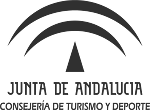Comparación del VO2máx y del tiempo hasta el agotamiento en dos modalidades de ejercicio en triatletas
Resumen
Comparación del VO 2máx y del tiempo hasta el agotamiento en dos modalidades de ejercicio en triatletas
Comparison of VO 2máx and time to exhaustion in two exercise modalities in triathletes
Resumen
Objetivo. El objetivo de este estudio fue comparar, en triatletas, si el tipo de ejercicio infl uye sobre el VO2máx obtenido en un test incremental y sobre el tiempo hasta el agotamiento (TTE) medido en un test de carga constante, realizado a la intensidad a la que se alcanzó el consumo máximo de oxígeno (IVO2máx) cuando son evaluados en la misma sesión. Método. Dieciséis triatletas varones (edad: 29,5 ± 8,4 años; peso: 71,7 ± 4,3, kg; estatura 174,8 ± 5,6 cm) realizaron un test incremental máximo para obtener el VO2máx y el IVO2máx y tras 30 minutos de recuperación un test de carga constante a la IVO2máx, para obtener el TTE. Éstos fueron realizados en cicloergómetro y tapiz aleatoriamente en dos días diferentes, con un período entre ambos de 7 días. Resultados. Se encontraron diferencias signifi cativas (p < 0,001) entre el VO2máx obtenido en el cicloergómetro (61,7 ± 5,8 ml/kg/min) y en el tapiz (65,6 ± 6,4 ml/kg/min). Por otro lado, en el TTE no se hallaron diferencias signifi cativas (p = 0,80) entre cicloergómetro y tapiz (222 ± 59,5 s frente a 238 ± 59,5 s respectivamente). Conclusiones. En triatletas el tipo de ejercicio infl uye sobre el VO2máx obtenido en un test incremental, mientras que parece no afectar el TTE, al menos cuando el test de carga continua se realiza en la misma sesión que el incremental.
Resumen
Purpose. The aim of this study was to analyze whether the kind of exercise performed by triathletes may have an infl uence on VO2max got by the incremental test, and on the time to exhaustion (TTE) assessed in a constant workload test at IVO2max, both been assessed and compared during the same session. Method. Sixteen male triatlethes (age: 29.5 ± 8.4 years; weight: 71.7 ± 4.3, kg; height: 174.8 ± 5.6 cm) have carried out a maximal incremental test so as to reach VO2max and IVO2max, and after 30 minute recovery time, they went through a constant workload test at IVO2max, so as to get the TTE. These tests were carried out at random on cycloergometer and on treadmill in two different days over a period between them of around 4 to 7 days. Results. Signifi cant differences were found (p < 0.001) between the VO2max got on the cycloergometer (61.7 ± 5.8 ml/kg/min) and on the treadmill (65.6 ± 6.4 ml/kg/min). Besides, on the TTE, there were no signifi cant differencies (p = 0.80), between the cycloergometer and the treadmill (222 ± 59.5 s vs. 238 ± 59.5 s, respectively). Conclusions. In triathletes, the kind of exercise has an infl uence on the VO2max got through an incremental test, while it seems not to infl uence the TTE, at least when the constant workload test is not carried out during the same session as the incremental test.
Palabras clave
VO 2max, Tiempo hasta el agotamiento, Test de carga continua
Keywords
VO 2max, Time to exhaustion, Constant workload test














